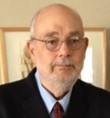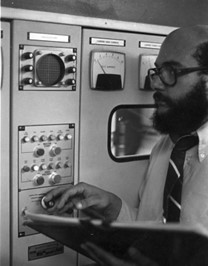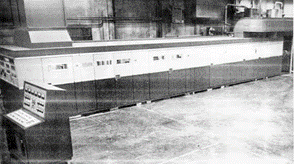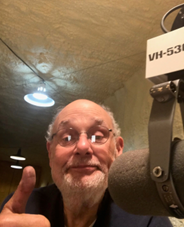Bruce Miller Earle
A well-known broadcaster in both North and South America, Bruce Miller Earle, passed away on October 2, 2023, from heart failure at the age of 72.

Bruce Miller Earle
January 1, 1951 – October 2, 2023
Bruce Miller Earle, or BME as his friends knew him, was born January 1, 1951 in Baltimore. Eventually, the family moved to Louisville, KY.
His first big break in broadcasting was in 1964, at age 13, working as a bench tech and remote engineer for the Sunday morning God Squad at WAKY in Louisville. He also worked at radio stations in San Marcos, Austin, Temple, Beaumont, Dallas. Laredo and El Paso.
In the Summer of 1968 he went to Elkins to get his FCC License.
NBC’s WRC in Washington DC was Bruce’s next stop. He was the transmitter engineer at WRC, and at the same time worked across town with Ed Buterbaugh at WEAM. There, they built a solid friendship that lasted for years to come.
HIGH POWER AM RADIO
The following year, BME headed to Tijuana, Mexico to work with and learn the ways of high-power AM RF propagation at 50 kW XERB (1090) with Nestor Cuesta.
The next stop was in 1972 when Earle becomes Engineering Consultant for Arthur Holt (Holt Media Brokerage) in Bethlehem, PA. Bruce and Arthur along with John Ryman formed the company World Broadcasting and purchased the operating & U.S. sales rights for XELO Juarez, Mexico.
Bruce handled rebuilding the old water-cooled Bill Branch hand-made 150 kW transmitter, while his close friend Greg Ogonowski revamped the audio system. The station was later renamed XEROK and X-Rock was heard in a large part of the US.
BUILDING RELATIONSHIPS
In 1973 Holt Media became involved with the upgrade & sales of WQRK in Norfolk.
BME did his audio & RF tweaks as Jay Blackburn, Director of Programming for Holt Media, puts on a pioneer “Q” format.
Bruce had been reading Claude Hall’s Vox Jox in Billboard since the late 60’s. Deciding it was time to meet him, he and Blackburn stormed the Billboard suite at the NAB in Washington D.C. with a case of Wild Turkey under his arm. Being a Texan, Hall smiled, “You old boys do come prepared. Now let’s have a drink.”
With that, their relationship was bonded forever. From then on they were best of friends.
BACK TO MEXICO AND HIGH POWER
Holt sent Bruce south of the border again in Summer 1973, this time to finally put the old Branch powerhouse transmitter down for good.
While the new 150 kW rig was being constructed in Dallas, the XELO transmitter was dismantled and replaced with a borrowed 10 kW Continental. Upon receiving the new Continental 318.5 rig, Bruce and Mexican engineer Sergio Cortez did the installation. (Bruce was fluent in Spanish, not only in speech but also reading and writing as well.)

Eventually, they purchased a used Continental 317C (50 kW) as the stand-by. Unfortunately, the GM sold the 317 to WZAM Norfolk. Bruce was really annoyed and had to purchase a Collins 5 kW as the standby.
KOMA, Oklahoma City was Bruce’s next destination. He was contracted in 1974 to work on the station’s 50 kW water-cooled Western Electric transmitter. At the time in Oklahoma, it was required for him to acquire a plumber’s license to work on the transmitter!.
Once KOMA was rebuilt, Bruce went North to be a staff engineer at CKLW. Getting to work with his good friend, BME said: “I’m on my way to work with one of the best AM engineers in the hemisphere – Mr. Ed Buterbaugh.”
But Bruce was not to stay long in Canada.
A GROUP CHIEF AT 24
Just as he started in at CKLW, a phone call changed things.
Unbeknownst to BME, Claude Hall had contacted Bruce Johnson, the new President of the Sterling Radio Organization (SRO), recommending Mr. Earle as the right choice for his upcoming Director of Engineering position.
Bruce was just 24, and had the dream offer of the DoE position set in front of him. With a heavy heart he had to tell Buterbaugh that he must accept this chance for a DoE position and Ed graciously accepted and understands.
SRO YEARS AND MORE FRIENDS
The Sterling Recreational Organization (SRO) started with KZOK-FM and KUUU-AM in Seattle.
One of the programs that ran on OK102 was The Marvel Comics Radio Series, produced in Seattle at the Kate Smith Recording Studios. Two of the producers Peter B. Lewis and P. Craig Turner had started a recording studio named Eye Ear productions. BME handled the engineering.
They studio needed a new audio board, so BME and Turner made a trip to Chicago where they inspected and purchased the Neuman/Telefunken Console on which Chess records had recorded The Rolling Stones Satisfaction. Later, Bruce would use it to produce the funky jingles for XEROK.
STILL MORE POWER
150 kW was a definitely complex transmitter to install and maintain. But more was coming.
In 1976, Bruce assisted his mentor and high-power RF guru Nestor Cuesta with putting a Continental D320 – a 1 Megawatt behemoth on 625 kHz – on the air in Cartago, Costa Rica.

BME considered Nestor to be the Mexican engineer counter-part of Weldon & Branch. Bruce would say “If you need high-power RF these are the guys that can do it” and “My life as a MW wave engineer was greatly influenced by Nestor taking me under his wing when I was 18.”
Over the years, Nestor put several high-power border blasters on the air, including XER, XEPN, XERB, and XEG. He also worked with William “Bill” Branch on projects at WBAP, XELO, and, along with James O. Weldon, XER/XERF.
His work was not all AM: in early 1977 Holt Brokerage was contracted to sell WSDM Chicago and Bruce found himself playing with a transmitter high atop the John Hancock building as Holt & Blackburn installed a new format (AOR) & changed the calls to WLUP.
But Mexico called again.
PART THREE IN JUAREZ
Bruce was then sent back to XEROK for what BME called “part three” – to finish what he started.
At that time, the station was using CBS Audimax and Volumax units for audio processing. (A little-known fact: at the time, due to the bad match of the antenna and transmitter, the audio was rolled off at eight kHz so the transmitter would not kick off – this was on orders from Continental.)
Bruce said: “At no time did any transmission from XEROK at Ciudad Jurez, Chih, Mexico ever exceed 150 kW in any form or fashion. The transmitters averaged a high-power operation of 142 kW during evening hours and 52 kW days. Because the Doherty amplifier did not like different power levels, the unit was tuned for optimum efficiency and audio response at high power – taking advantage of the huge night time sky wave signal.
MAKING A TRANSMITTER SING!
Like his friend, Ed Buterbaugh, Bruce insisted that fidelity be maximized to its fullest potential and decided to process it like an FM.
Buterbaugh was a huge technical inspiration for the development of the X-Rock’s audio processing system. Bruce & Ed were two of a handful of engineers who truly know how to “make the X-Rock box talk.”
Bruce rebuilt the open transmission line and antenna matching units so as to promote better side-band response either side of XEROK’s 800 kHz signal. He then threw away the old CBS gear and replaced it with a pair of graphic equalizers, two UREI LA-4s, 1 UREI 1176, and a custom peak clipper.
He then built an a active-balanced differential input in the front end of the transmitter and managed to hit 100% modulation with virtually no distortion and PA efficiency of 85%. Even J.O. Weldon was impressed.
IN THE AIR EVERYWHERE
In the 1980s, Holt was very active with brokerage, reorganization, upgrade, and liquidation of several stations across the country. Bruce & Jay were sent to every one, where they did their magic and then moved onto the next.
In 1989, Bruce and Cynthia purchase a home near Mexico City as Mr. Earle takes over engineering and programming for XHFAJ – Alfa 91.3. There, he upgraded the transmitter, increasing power from 62 kW to 99.45 kW. Armed with a hybrid Drake/Blackburn format, he took the station to number one and stayed at the top of the Nielson ratings for three solid years. It was the
- First station in Mexico City to broadcast a full-time American Top 40 format, and becoming a ratings winner.
- First station in Mexico City to broadcast jingles in English.
- First station in Mexico City with a mobile studio.
- First station in Mexico to broadcast live rock concerts.
Alfa 91.3 paved the way for commercial radio in Mexico
TIME FOR TEXAS
They moved back to Texas in 1993, this time to Laredo as the BME purchased KZZQ-FM and turns it into KBDR “Border Radio” with the Alfa format.
The station was sold around 2002 they sell KBDR, so they could move up to the Texas hills area of Wimberley/New Braunfels and served as Engineering Consultant for several San Antonio stations and the CBS group.
In the early 2000’s he went to Eastern China to oversee construction and operations of one of China’s largest telecommunications suites.
ALMOST RETIRED
The Earls move for the last time in 2022, to be “close to the grand-kids” in Garland.
Still, Bruce worked as much as he could. His last project was in 2020 to build VH 530, a 100 kW DA1 on 530 kHz in the Turks and Caicos Islands. Bruce built a home studio and armed with VO talent Big Jim Edwards “Davis” of CKLW fame on ID’s and imagining liners, once a month for three hours he would produce an “oldies hits” show during prime skywave hours.

Health issues cropped up late in life, Bruce was diagnosed with a failing liver and received a transplant. But, it was heart failure that claiomed him in October 2023.
Bruce is survived by Cynthia, his wife of 43 years, son, Henry, and 5 grandkids.
– – –
We wish to sincerely thank Donald Keith Morgan for his kind help in putting this history of Bruce Miller Earle together.
– – –
Would you like to know when more articles like this are published? It will take only 30 seconds to
click here and add your name to our secure one-time-a-week Newsletter list.
Your address is never given out to anyone.
